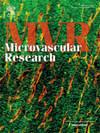鉴定剪切应力作为微血管网络的潜在血管传导信号。
IF 2.7
4区 医学
Q2 PERIPHERAL VASCULAR DISEASE
引用次数: 0
摘要
本研究的目的是通过计算估计血管特异性血管收缩对微血管网络即时剪切应力变化的影响。微血管血流引起的剪切应力是离子介导的微血管信号传导的起始点,它调节微循环血流的控制。然而,除了在血管中启动局部血管舒缩外,剪切应力作为血管传导信号本身以及流体动力学通过血流传播的特征还没有得到很好的理解。在目前的工作中,我们使用成年大鼠组织的肠系膜微血管网络图像和网络段血流模型来模拟各种血管收缩情景,并估计随后的剪切应力变化以及这些变化从收缩部位传播的距离。除了肌肉组织的微血管网络外,还考虑了涉及小动脉收缩和毛细血管收缩的情况。研究结果普遍揭示了所有情况下神经网络的非均质和生理相关的剪切应力变化,其幅度跨越广泛,可超过30达因/平方厘米。此外,在距离刺激部位几毫米的距离上预测了生理相关的壁剪切变化。剪切应力随网络拓扑结构和毛细密度的空间变化规律也得到了识别。总之,这些结果激发了对剪切应力作为血管传导反应的潜在参与者的考虑和讨论。本文章由计算机程序翻译,如有差异,请以英文原文为准。
Identification of shear stress as a potential vasoconduction signal across microvascular networks
The objective of this study was to computationally estimate the effects of vessel specific vasoconstriction on immediate shear stress changes across microvascular networks. Shear stress due to microvascular blood flow is an established initiator of ion-mediated signaling along microvessels which regulates control of microcirculatory blood flow. Yet, beyond initiating local vasomotion in a vessel, shear stress as a vasoconduction signal itself and characteristics of hydrodynamic propagation via blood flow are not well understood. In the current work, we use images of mesenteric microvascular networks from adult rat tissues and a network segmental blood flow model to simulate various vessel constriction scenarios and estimate subsequent shear stress changes and distances these changes spread from the site of constriction. Scenarios involving both arteriolar constriction and capillary constriction are considered, in addition to a microvascular network from muscle tissue. The findings generally reveal heterogenous and physiologically relevant shear stress changes across the networks for all cases, with magnitudes spanning a wide range and can exceed 30 dyne/cm2. Further, physiological relevant wall shear changes were predicted at distances several mm from the stimulus site. Spatial patterns of shear stress change relative to network topology and capillary density are also identified. Altogether, the results invigorate consideration and discussion about shear stress as a potential player in vasoconduction responses.
求助全文
通过发布文献求助,成功后即可免费获取论文全文。
去求助
来源期刊

Microvascular research
医学-外周血管病
CiteScore
6.00
自引率
3.20%
发文量
158
审稿时长
43 days
期刊介绍:
Microvascular Research is dedicated to the dissemination of fundamental information related to the microvascular field. Full-length articles presenting the results of original research and brief communications are featured.
Research Areas include:
• Angiogenesis
• Biochemistry
• Bioengineering
• Biomathematics
• Biophysics
• Cancer
• Circulatory homeostasis
• Comparative physiology
• Drug delivery
• Neuropharmacology
• Microvascular pathology
• Rheology
• Tissue Engineering.
 求助内容:
求助内容: 应助结果提醒方式:
应助结果提醒方式:


